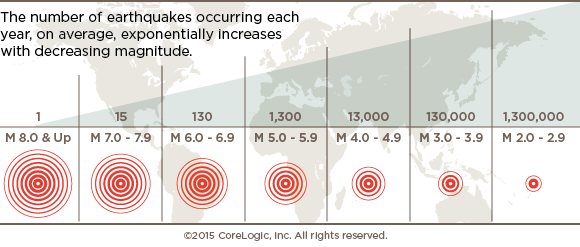This post is part of a series sponsored by CoreLogic
Earthquakes have the potential to cause major destruction and disruption to society. Damage caused by earthquakes can be catastrophic and can have both a humanitarian and financial impact. So when an earthquake occurs, having a prompt understanding of potential catastrophic consequences is critical for risk managers, who rely on this information to make informed decisions about how to manage the impact of disastrous events. With services like the USGS Earthquake Notification Service (ENS) providing readily available, automated earthquake notifications, obtaining information about earthquake activity around the world is now easier than ever.
Several million earthquakes occur each year worldwide, but many of these are actually insignificant (i.e. too small or in remote locations), and should not cause any great concern. Despite the large number of events, the USGS locates approximately 50 earthquakes each day, or about 20,000 a year. Fortunately, only a small number of these annual events will cause any significant damage. So when you receive a notification that there has been an earthquake, how do you know if you need to be concerned? Here’s my advice: Think like a seismologist!

Recent Large Earthquakes around the Globe
Before we dive into the specifics of thinking like a seismologist, let’s review the most recent large earthquakes that have occurred around the world. In 2011, an M9.0 earthquake struck off the coast of Japan causing a massive tsunami which lead to more than $200 billion in economic damages and more than 19,000 lives lost. Also in 2011, a series of strong earthquakes struck the Canterbury region of New Zealand–cumulatively leading to more than $15 billion in economic loses[1]. So far in 2015, eleven earthquakes have been recorded in the M7 to M8 range[2]. This includes the devastating earthquakes to strike Nepal in April and May, but most of the others occurred in remote locations far away from any exposure. Since the time of the Great Tohoku earthquake in Japan, one of the largest earthquakes to occur globally has been a M8.3 earthquake off Russia’s Kamchatka Penninsula, in the Sea of Okhotsk in May 2013. This event is a great example of a very large magnitude event that should not cause concern, as although a M8.3 earthquake is very large, it not only occurred in a low-exposure area–more importantly, it was approximately 600km deep, and earthquakes of this depth are actually too deep to cause damage. More recently, an M8.3 earthquake occurred off the coast of Chile on September 16, 2015. Compared to the earthquake of the same magnitude in the Sea of Okhotsk, the Chile earthquake was shallow and produced strong ground motions on land. Fortunately, the event was still quite a distance from larger cities and concentration of exposure in Chile and the losses were relatively low given the very large magnitude.
Understanding Big Earthquakes
As unpredictable as earthquakes can be, there is one thing that is very intuitive: the larger the magnitude, the greater the potential of damage. Or more simply –big earthquakes cause more damage than small earthquakes. However, it’s not just magnitude that needs to be considered, as sometimes a smaller magnitude earthquake can cause more damage than one of larger magnitude.
When you hear of the potential of an earthquake occurring, what you really want to know is – Will it be damaging? So, to get a quick understanding of the possible extent of the damage, here are three quick tips on how to think like a seismologist. There’s more to consider than just magnitude!
Tips to Think Like a Seismologist
- Location-Is the epicenter, or rupture area, close to major exposure?
Just like in real estate – location can make all the difference. The strongest ground motions are generally recorded within 50km of the epicenter or rupture area, depending on the underlying soil conditions. An example of this is the 2010-2011 earthquakes in New Zealand. The February 2011, M6.1 earthquake in Christchurch was a direct hit on the city. Compare this to the larger September 2010, M7.0 event about 40km west of the city, which was far less damaging.
A large earthquake closer to the area of exposure will yield a much more damaging event. Compare the level of shaking intensity in the city of Christchurch in the following images. In the September 2010 event (left) the more severe ground shaking is away from the city, compared to the February 2011 event, where the severe ground shaking intersected with the city.

2. Depth- How deep is this earthquake?
If the earthquake is shallow (i.e. less than 30 km), be concerned, especially if it’s near exposure. (Don’t forget tip #1 – Location!). If it’s an intermediate depth (i.e. 50-150 km) it will likely cause less damage, but the footprint could be larger because of the way seismic waves travel. If it’s deeper than 200km, there’s no need to worry. The event is too deep to cause much damage.
For example, the M8.3 earthquake off Russia’s Kamchatka Peninsula mentioned previously – is much too deep to cause damage. An earthquake at a depth of 600km – that’s like being 600km away from the epicenter at the epicenter. As such, only a moderate level of shaking occurred from this M8.3 event.
3. Construction Practices/ Building Codes- What is the construction quality like?
In addition to location and depth, you must consider the construction quality in the location of the earthquake:
- Is this an area that typically sees earthquake damage, especially from moderate magnitude earthquakes?
- Is the country known for having a strong building code?
An earthquake with the same magnitude and depth could cause drastically different damage depending on the vulnerability of the exposure. For example, a M6 earthquake in California or Japan could cause very little damage due to the stringent seismic provisions in the building codes. But in other countries with very old construction (especially unreinforced masonry or adobe structures), a M6 earthquake could be extremely damaging in countries as experienced in Italy or Greece, or very poor construction practices like experienced in Haiti.
Conclusion
To fully understand if an earthquake has the potential to cause damage, there are many other aspects to consider other than magnitude. Yet a perspective of location, depth, construction practices and magnitude, are just a few quick starting points to consider when evaluating your potential need for concern.
In general, a good rule to follow is that earthquakes with a large magnitude, near an urban center should cause concern. In countries with high quality construction practices it generally takes an earthquake M6.0 or greater to cause structural damage. Slight damage can occur in the M5.5 to 6.0 range, and minor damage for magnitudes lower than M5.5. Major earthquakes with magnitudes of M7.0 and greater near urban centers, especially those with shallow depths are of major concern as they can cause significant damage and devastation[3].
Learn More
To learn more about Catastrophe Risk Management from CoreLogic, click here
Call us at (855) 267-7027 or email us at hazardrisk@corelogic.com.
[1] http://media.swissre.com/documents/sigma2_2012_en.pdf
[2] http://earthquake.usgs.gov/earthquakes/search/
[3] http://www.geo.mtu.edu/UPSeis/magnitude.html
Was this article valuable?
Here are more articles you may enjoy.



 AIG General Insurance Chairman McElroy to Retire May 1
AIG General Insurance Chairman McElroy to Retire May 1  How California’s Huge Raises for Fast-Food Workers Will Ripple Across Industries
How California’s Huge Raises for Fast-Food Workers Will Ripple Across Industries  Marsh McLennan Agency to Buy Fisher Brown Bottrell for About $316M
Marsh McLennan Agency to Buy Fisher Brown Bottrell for About $316M  Vintage Ferrari Owners’ Favorite Mechanic Charged With Theft, Fraud
Vintage Ferrari Owners’ Favorite Mechanic Charged With Theft, Fraud 


